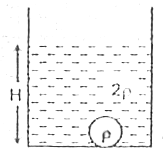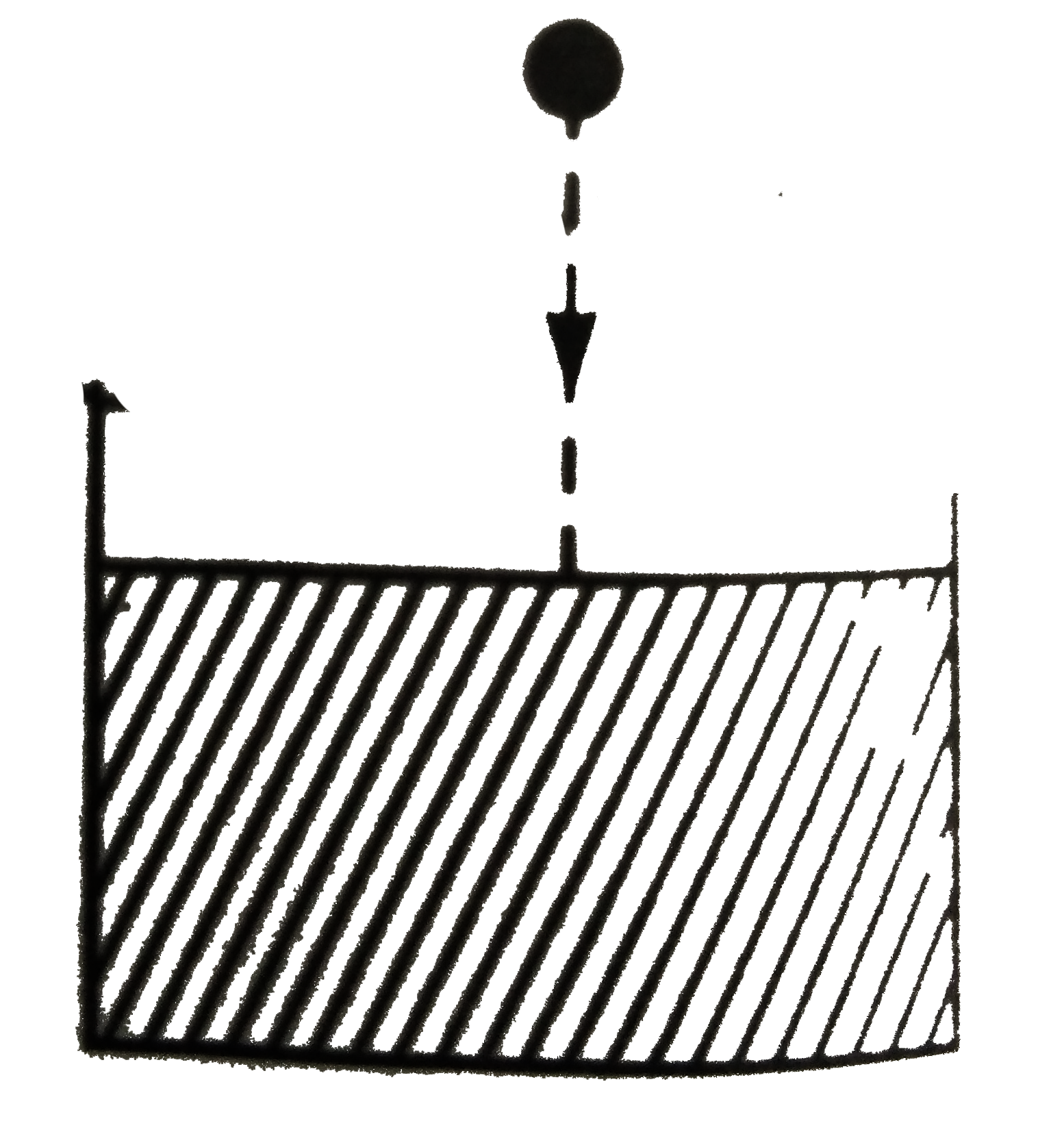A small ball of mass M and density ρ is dropped in a viscous liquid of density ρ0 . After some time, the ball falls with a constant velocity. What is the viscous force on the ball?
F=Mg(1+ρ0ρ)
F=Mg(1+ρρ0)
F=Mg(1−ρ0ρ)
F=Mg(1±ρρ0)
The correct Answer is:C
To solve the problem, we need to analyze the forces acting on the ball when it reaches a constant velocity (terminal velocity) while falling through the viscous liquid.
1. Identify the Forces Acting on the Ball:
When the ball is dropped into the viscous liquid, there are two main forces acting on it:
- The gravitational force (weight) acting downwards: Fg=mg
- The viscous force acting upwards: Fv
2. Understand Terminal Velocity:
When the ball falls with a constant velocity, it means that the net force acting on the ball is zero. This condition is known as terminal velocity. Therefore, we can write:
Fg−Fv=0
This implies:
Fg=Fv
3. Express the Gravitational Force:
The gravitational force acting on the ball can be expressed as:
Fg=mg
where m is the mass of the ball and g is the acceleration due to gravity.
4. Calculate the Mass of the Ball:
The mass m of the ball can be expressed in terms of its density ρ and its volume V:
m=ρV
5. Calculate the Volume of the Ball:
The volume V of the ball can be expressed as:
V=mρ
6. Express the Viscous Force:
The viscous force Fv can be expressed in terms of the density of the liquid ρ0 and the volume of the ball:
Fv=ρ0Vg
Substituting V from the previous step, we get:
Fv=ρ0(mρ)g
7. Set the Forces Equal:
Since Fg=Fv, we can set the two expressions equal to each other:
mg=ρ0(mρ)g
8. Simplify the Equation:
Dividing both sides by g (assuming g≠0):
m=ρ0mρ
Rearranging gives:
1=ρ0ρ
9. Calculate the Viscous Force:
The viscous force can now be expressed as:
Fv=mg−Fv
Rearranging gives:
Fv=mg−(1−ρ0ρ)mg
Thus, the viscous force on the ball is:
Fv=mg(1−ρ0ρ)
Final Answer:
The viscous force on the ball is:
Fv=mg(1−ρ0ρ)
When the ball is dropped into the viscous liquid, there are two main forces acting on it:
- The gravitational force (weight) acting downwards: Fg=mg
- The viscous force acting upwards: Fv
When the ball falls with a constant velocity, it means that the net force acting on the ball is zero. This condition is known as terminal velocity. Therefore, we can write:
Fg−Fv=0
This implies:
Fg=Fv
The gravitational force acting on the ball can be expressed as:
Fg=mg
where m is the mass of the ball and g is the acceleration due to gravity.
The mass m of the ball can be expressed in terms of its density ρ and its volume V:
m=ρV
The volume V of the ball can be expressed as:
V=mρ
The viscous force Fv can be expressed in terms of the density of the liquid ρ0 and the volume of the ball:
Fv=ρ0Vg
Substituting V from the previous step, we get:
Fv=ρ0(mρ)g
Since Fg=Fv, we can set the two expressions equal to each other:
mg=ρ0(mρ)g
Dividing both sides by g (assuming g≠0):
m=ρ0mρ
Rearranging gives:
1=ρ0ρ
The viscous force can now be expressed as:
Fv=mg−Fv
Rearranging gives:
Fv=mg−(1−ρ0ρ)mg
Thus, the viscous force on the ball is:
Fv=mg(1−ρ0ρ)
The viscous force on the ball is:
Fv=mg(1−ρ0ρ)
Topper's Solved these Questions
Similar Questions
A small ball of mass m and density ρ is dropped in a viscous liquid of density σ. Ather some time the ball falls with a constant velocity. Calculate the viscous force acting on the ball.
View SolutionThe velocity of a small ball of mass M and density d when dropped in a container filled with glycerine becomes constant after sometime. If the density of glycerine is 'd/2' then the viscous force acting on the ball will be
View Solution
Knowledge Check
A ball of density ρ is released from deep inside of a liquid of density 2ρ. It will move up
Awith an increasing accelerationBwith a decreasing accelerationCwith a constant accelerationDwith zero accelerationStatement -1 : A tiny shere of mass m and density ρ is dropped in a tall jar of glycerine of density ρ0 . When the sphere acquires terminal velocity v, the magnitude of viscous force is mg(1−ρ0/ρ).
Statement -2 : Viscous force on the body falling in a medium is F=6πηrv , where η is the coeff. of viscosity of medium and r is the radius of bodyAStatement -1 is true , Statement -2 is true , Statement -2 is a correct explanation of Statement -1.BStatement -1 is true , Statement -2 is true , Statement -2 is not a correct explanation of Statement -1.CStatement -1 is true, Statement -2 is false.DStatement -1 is false , Statement -2 is true.A tiny sphere of mass m and density x is dropped in a jar of glycerine of density y. When the sphere aquires terminal velocity, the magnitude of the viscous force acting on it is :
AmgxyBmgyxCmg[1−yx]Dmg[1+yx]
A small ball of density ρ is placed from the bottom of a tank in which a non viscous liquid of density 2ρ is filled . Find the time taken by the ball to reach the surface of liquid and maximum height reached above the bottom of container . (Size of the ball and any type of drag force acting on the ball are negligible )

View SolutionA ball of density ρ is dropped from a height on the suraca of a non-visous liquid of dinsity 2ρ. Choose the correct options.

View SolutionThe velocity of small ball of mass M and density d1 when dropped in a container filled with glycerin becomes constant after sometime. If the density glycerin of is d2, the viscous force acting on ball is
View SolutionA spherical ball of density σ is freely falling in a viscous liquid of density p(p<σ). The initial acceleration of the ball will be
View SolutionA solid ball of density ρ1 and radius r falls vertically through a liquid of density ρ2. Assume that the viscous force acting on the ball is F=krv, where k is a constant and v its velocity. What is the terminal velocity of the ball ?
View Solution
